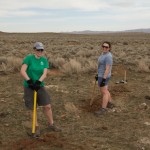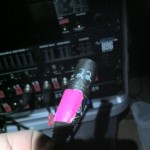On Sunday we had a break in our atypical windy mornings, and I was able to collect our first sound recordings of the season on Chugwater Lek. A long afternoon the day before by our crew helped get the microphones in place. We didn’t have any particular reason to limit the number of microphones this year, so we buried cables for 11 microphones this year instead of 8. The core area of birds is so dense that any improvement in accuracy of our acoustic location system might pay off in more calls assigned to individual males during analysis.
The recording itself went relatively smoothly. I relabeled the cables in the blind so it would be as easy as possible to place the cables in the correct channel in the preamps. Staring at the end of the cable and seeing the many numbers this cable had already received made me feel a bit like an archeologist. There’s the worn and faded numbers from it’s original installation, the pink duct tape from the Blickley era, and other numbers indicative of other arrays on other leks that this cable had been a part of. It’s not always a given that things will be labeled on both ends, and I was left with two cables that I thought I knew where they went but wasn’t entirely sure. At the end of the morning I did a quick test by continuing to record while I picked up the microphones in order, just to make sure we knew which mic was actually connected to each channel. Good thing, as those two were mixed up! It’s always a good idea to double-check anything you do early in the morning.


